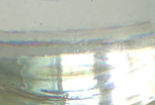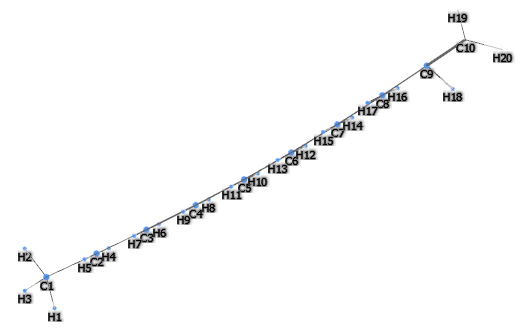| "Descrizione" by FRanier (9971 pt) | 2024-Oct-10 15:58 |
Review Consensus: 10 Rating: 10 Number of users: 1
| Evaluation | N. Experts | Evaluation | N. Experts |
|---|---|---|---|
| 1 | 6 | ||
| 2 | 7 | ||
| 3 | 8 | ||
| 4 | 9 | ||
| 5 | 10 |
Hydrogenated polydecene is a natural product, a polyolefin hydrocarbon (belongs to the polymers, macromolecules monomers of olefins derived from the polymerisation of natural gas or oil) obtained chemically, i.e. synthesised through a hydrogenation process. It is a polyene, with simple hydrocarbon structures with no functional groups other than alkenes or alkanes, produced by the polymerisation of vinyl monomers such as alkenes or olefin and obtained from the hydrogenation of polydecene. It is a polymeric ingredient using an ethylene unit.
Polydecene is a branched aliphatic solvent.
Chemical Composition and Structure
Hydrogenated Polydecene is a linear polymer of decene, an unsaturated hydrocarbon, which undergoes a hydrogenation process to stabilize its chemical structure. This process removes double bonds, converting the polymer into a saturated compound. Its chemical structure gives it highly emollient properties and a light texture that absorbs easily into the skin.
Physical Properties
It is a clear, colorless, and odorless liquid with a lightweight, non-greasy texture. It is insoluble in water but blends well with oils and other lipid-based ingredients, making it easy to incorporate into cosmetic formulations. Due to its low volatility, it provides long-lasting hydration for both skin and hair.
Production Process
Hydrogenated Polydecene is produced through the polymerization of decene, a 10-carbon hydrocarbon, followed by hydrogenation. The hydrogenation process saturates the polymer, making it chemically stable and less reactive, which ensures its safety and durability in cosmetic formulations.
The name defines the structure of the molecule:
- Hydrogenated refers to the hydrogenation process, a chemical reaction that adds hydrogen to another substance. In the context of cosmetics and personal care products, hydrogenation is often used to transform liquid oils into solid or semi-solid fats, which can improve the consistency and stability of the product.
- Polydecene refers to a polymer consisting of decene, a type of alkene with ten carbon atoms. Polymers are large molecules composed of repeated subunits and are often used in cosmetics and personal care products for their ability to form films, among other properties.
The synthesis process takes place in several stages:
- Polymerization. The first phase involves polymerization of decene, an alpha-olefin, to form polydecene. This is achieved by using a catalyst, often a type of Ziegler-Natta catalyst, which allows the decene molecules to link together and form a polymer.
- Hydrogenation. The resulting polydecene is hydrogenated by the reaction of polydecene with hydrogen in the presence of a catalyst. The hydrogenation process adds hydrogen atoms to the polydecene, saturating the carbon-carbon bonds. This makes the resulting hydrogenated polydecene more stable and less likely to react with other substances.
- Purification. Hydrogenated Polydecene is purified to remove any residual catalyst and unreacted decene. This involves a series of washing and filtration steps.
- Quality control. The final product is tested to ensure it meets the specifications required for use in cosmetics and personal care products. This includes control of molecular weight, viscosity, and purity.
It appears as a clear, tasteless, odourless, oily liquid with high oxidation, pH and temperature stability in the range -60°C to 220°C, good photostability and UV transparency. Soluble in many non-polar solvents such as cyclomethicones, esters, ethers, saturated and unsaturated triglycerides, mineral oils and fatty alcohols. Insoluble in organic solvents or water.

What it is used for and where
Hydrocarbon surfactant with high surface tension.
Pharmaceutical
Hydrogenated polydecene has a skin care function as an emollient.
Cosmetics
Fragrance. It plays a very important role in the formulation of cosmetic products as it allows perfume to be enhanced, masked or added to the final product, improving its commercial viability. The consumer always expects to find a pleasant scent in a cosmetic product.
Hair conditioning agent. A large number of ingredients with specific purposes can co-exist in a hair shampoo: cleansers, conditioners, thickeners, mattifying agents, sequestering agents, fragrances, preservatives, special additives. However, the indispensable ingredients are the cleansers and conditioners as they are necessary and sufficient for hair cleansing and manageability. The others act as commercial and non-essential auxiliaries such as: appearance, fragrance, colouring, etc. Hair conditioning agents have the task of increasing shine, manageability and volume, and reducing static electricity, especially after treatments such as colouring, ironing, waving, drying and brushing. They are, in practice, dispersing agents that may contain cationic surfactants, thickeners, emollients, polymers. The typology of hair conditioners includes: intensive conditioners, instant conditioners, thickening conditioners, drying conditioners.
Skin conditioning agent - Emollient. Emollients have the characteristic of enhancing the skin barrier through a source of exogenous lipids that adhere to the skin, improving barrier properties by filling gaps in intercorneocyte clusters to improve hydration while protecting against inflammation. In practice, they have the ability to create a barrier that prevents transepidermal water loss. Emollients are described as degreasing or refreshing additives that improve the lipid content of the upper layers of the skin by preventing degreasing and drying of the skin. The problem with emollients is that many have a strong lipophilic character and are identified as occlusive ingredients; they are oily and fatty materials that remain on the skin surface and reduce transepidermal water loss. In cosmetics, emollients and moisturisers are often considered synonymous with humectants and occlusives.
Solvent. It is a substance for dissolving or dispersing surfactants, oils, dyes, flavourings, bactericidal preservatives in solution.
Applications
Hydrogenated polydecene is included in cosmetic formulations such as foundations, make-up products, gels, serums, emulsions, sticks as an emollient agent. In hair care products it can increase combability and shine and has an anti-frizz effect.
- Skin Care Products: Hydrogenated Polydecene is commonly found in skin care products such as lotions, creams, and serums. Its emollient properties help to soften and smooth the skin.
- Hair Care Products: In hair care formulations like shampoos, conditioners, and styling products, Hydrogenated Polydecene can help improve texture, increase shine, and offer conditioning properties.
- Makeup: Due to its silky and non-greasy feel, it's used in various makeup products like foundations, lipsticks, and mascaras. It provides a smooth application and can help in spreading pigments evenly.
- Sunscreens: Hydrogenated Polydecene can be found in sun care products due to its ability to improve the spreadability and feel of the product on the skin. In sunscreen products in oil/water formulations and in creams it can help the sunscreen to disperse evenly in the oil phase.
- Bath Products: This ingredient can be used in bath oils and other similar products to enhance the skin feel.
- Antiperspirants and Deodorants: Its inclusion in these products can enhance the texture and improve application.
- Texture Enhancer: Hydrogenated Polydecene often acts as a texture enhancer in cosmetic formulations, giving products a silky, luxurious feel.
Health and Safety Considerations
Safety in Use
Hydrogenated Polydecene is considered safe for use in cosmetics and personal care products. It is non-irritating, non-comedogenic, and non-sensitizing, making it suitable for all skin types, including sensitive skin. Its stable chemical structure makes it highly safe in cosmetic formulations.
Allergic Reactions
Allergic reactions to Hydrogenated Polydecene are extremely rare. However, as with any ingredient, individuals with very sensitive skin should perform a patch test before extended use.
Toxicity and Carcinogenicity
It is widely used in cosmetic formulations and is considered safe at all concentrations approved by international regulatory bodies.
Environmental and Safety Considerations
Hydrogenated Polydecene is a synthetic, non-biodegradable compound, raising concerns about its environmental impact. While it is not considered immediately hazardous to the environment, proper disposal of products containing it is important to prevent long-term accumulation, particularly in aquatic systems.
Regulatory Status
Hydrogenated Polydecene is approved for use in cosmetics and personal care products by major regulatory authorities, including the European Union and the Food and Drug Administration (FDA) in the United States. It is considered safe and is used in various cosmetic formulations at different concentrations.
Hydrogenated polydecene generally does not contain solvent residues and the CIR Expert Group on the Safety of Ingredients in Cosmetics concluded that this ingredient is safe in cosmetics in current usage practices and in the concentrations described in the safety assessment (1).
The most relevant studies on this chemical compound have been selected with a summary of their contents:
Hydrogenated polydecene studies
Typical commercial product characteristics Hydrogenated polydecene
| Appearance | Oily liquid |
| Boiling Point | 316ºC |
| Melting Point | -66.3ºC |
| Flash Point | 113°C |
| Density | 0.85 g/mL at 25ºC |
| LogP | 3.92300 |
| Index of Refraction | n20/D 1.47 |
| Safety |  |
 |  |
 |  |
- Molecular Formula C10H20
- Linear Formula [CH2CH[(CH2)7CH3]]n
- Molecular Weight 140.27
- Exact Mass 140.15700
- CAS 68037-01-4 872-05-9
- UNII 7O4U4C718P
- EC Number 500-183-1
- DSSTox Substance ID DTXSID8027329
- IUPAC dec-1-ene
- InChI=1S/C10H20/c1-3-5-7-9-10-8-6-4-2/h3H,1,4-10H2,2H3
- InChl Key AFFLGGQVNFXPEV-UHFFFAOYSA-N
- SMILES CCCCCCCCC=C
- MDL number MFCD00677706
- PubChem Substance ID 24869967
- ChEBI 87315
- ICSC 1477
- NSC 62122
- NACRES NA.23
- RTECS HE2071401
- UN 3295 1993
- NCI
Synonyms:
- Poly(1-decene)
- 1-Decene
- Decylene
- Poly Alpha Olefin
References_____________________________________________________________________
(1) Burnett, C. L., Bergfeld, W. F., Belsito, D. V., Hill, R. A., Klaassen, C. D., Liebler, D. C., ... & Heldreth, B. (2020). Safety Assessment of Polyene Group as Used in Cosmetics. International journal of toxicology, 39(2_suppl), 59S-90S.
| Evaluate |

